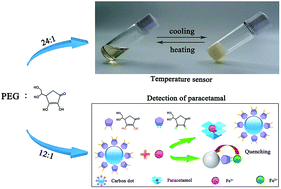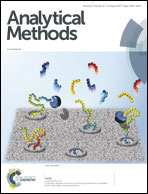Preparation of carbon nanodots capped by polyethylene glycol as a multifunctional sensor for temperature and paracetamol†
Abstract
In this paper, a simple and green preparative strategy for synthesizing carbon nanodots (CNDs) is developed by a one-pot hydrothermal method, using ascorbic acid (AA) as the carbon source and polyethylene glycol (PEG) with a molecular weight of 1500 as the surface modification agent. Through changing the amount ratio of PEG-1500 to AA in the synthesis, we can obtain PEG-CNDs with different functions. For example, due to the thermosensitivity of PEG-1500, the as-prepared PEG1-CNDs exhibit unique temperature sensitivity when the mass ratio of PEG-1500 to AA is 24 : 1. A reversible change of PEG1-CNDs from the solid state to transparent solution with increasing temperature can be repeated several times. The optical transmittance signal of PEG1-CNDs linearly responds to temperature in the range of 20–65 °C. Besides, while the amount ratio of PEG-1500 to AA is 12 : 1, the obtained PEG2-CNDs lose thermal sensitivity and form a stable and fluorescent solution at room temperature. The emission of PEG2-CNDs can be quenched by Fe3+, while with the addition of paracetamol (PAR), the fluorescence is recovered because of forming chelates between Fe3+ and PAR. Under the optimized conditions, the linear range of PAR obtained is 0.03–30 μM with a detection limit of 13 nM. Finally, the proposed method is successfully applied to detect PAR in human serum and urine samples with satisfactory recoveries.



 Please wait while we load your content...
Please wait while we load your content...